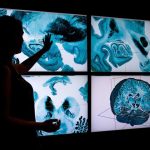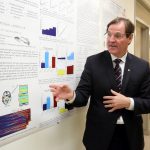The MCIN was the recipient of a generous donation from the EMC Corporation. This piece of technology will greatly assist in the advancement of neuroscientific research.
From the McGill Newsroom
Creation of neuroscience research hub
The Canadian research team that helped spearhead the international brain-mapping project known as BigBrain is about to get a major boost in its effort to produce sharply higher-resolution brain maps, thanks to technology from EMC Corporation.
McGill will establish a research-and-development centre that will serve as a test bed to adapt EMC Isilon scale-out NAS for powerful visualization and data-storage technology to support the complex needs of leading-edge neuroscience. The new centre will be expanded in coming years to encompass research across the university, reflecting the increased role of Big Data in research in the social sciences and arts, as well as natural sciences.
“EMC’s next-generation technologies, being harnessed by McGill University, provides researchers an advanced and agile foundation for healthcare and life sciences professionals to store, protect, share, and analyze their most valuable asset: information,” said Mike Sharun, EMC Corporation of Canada Country Manager. “Ultimately, this research powered by EMC technology will have true value for healthcare providers worldwide.”
Developing a fuller understanding of the brain’s circuitry represents a huge challenge, with an estimated 100 billion neurons in the brain and 1000 trillion neuronal connections (10,000 per neuron) triggering thoughts and actions. It’s also a key step toward translating neuroscience research into clinical practice and public health in ways that will improve brain health in Canada and around the world.
“A single high-resolution dataset for a full brain now requires over 200 terabytes of disk space for raw data alone,” says Alan Evans, the McGill brain-imaging expert who worked with European scientists to produce the BigBrain map. That effort required years of data processing by supercomputers in Canada and Germany. But recent computer advances have now made it possible to take map images in much finer detail.”
A global data-sharing network for brain research
“EMC’s storage and visualization technologies will help us take brain imaging to the next level – from the equivalent of old fashioned street maps to Google Earth,” Evans says. “We are also building a global data-sharing network for brain research that requires immense data storage and processing resources. EMC’s technology support will give Canada a leading role in the rapidly evolving global enterprise.”
Strengthening brain research across Canada
EMC’s work with McGill also promises to bolster brain research across Canada. McGill is the hub for CBRAIN, a high-performance computing platform that acts as a portal to the Compute Canada grid of computer processors at research institutions across the country. Using Isilon scale-out NAS technology, the EMC-McGill infrastructure will tie into that network, which supports over 400 users in the Americas, Europe and Asia involved in research on Alzheimer’s disease and a range of other conditions.
The NeuroHub will also be an important link with brain researchers in the US, Europe, China and Latin America, and will be used by neuroscientists working with different types of brain data – involving, for example, genetics, imaging, tissue samples, or behavioural assessments.
“McGill is proud to take this remarkable step forward in collaboration with EMC Canada,” said Rosie Goldstein, McGill University (Vice-Principal – Research and Innovation). “The highly specialized technology and high velocity data capture made possible by NeuroHub will enable researchers to better understand existing pathologies and predict treatment outcomes. We believe that this remarkable collaboration between EMC Canada and McGill researchers from across disciplines will have important outcomes.”
From the Montreal Gazette
The Montreal Neurological Institute is poised to advance 3D brain-mapping research down to the cellular level, raising hopes ultimately for treatments into neurodegenerative diseases like Alzheimer’s and Parkinson’s.
The MNI announced on Wednesday that it has received $1 million worth of supercomputing data-storage technology from EMC Corporation of Toronto. The donation will allow researchers to map the human brain to a degree of precision that would have been unthinkable a generation ago.
Alan Evans, director of the McGill Centre for Integrative Neuroscience, predicted the technology will usher in a new golden age in brain research at the MNI.
“Montreal has been a capital of brain research from the days of (Wilder) Penfield,” Evans said, referring to the legendary neuroscientist who founded the MNI in 1934.
“What is happening right now is we are rebuilding our position at the top of the global tree in brain research using information technology and using what we call brain mapping — where you are no longer describing disease, you are quantifying it, you are measuring it, you are looking across hundreds or even thousands of individual brains to understand variability in the brain.”
At present, brain surgeons and neuroscientists often rely on the inky images of two-dimensional MRI scans. What Evans and his colleagues are seeking to accomplish is a three-dimensional atlas of the brain right down to the level of neurons.
That poses an enormous challenge, given that the brain contains about 100 billion neurons and 1,000 trillion neuronal connections. In order to achieve that goal, the MNI needs lots of supercomputing power and plenty of data storage. That’s where EMC Corporation comes in, with its “Isilon scale-out NAS” technology.
In a world first three years ago, Evans’ team and German neuroscientists produced the Big Brain, a 3D computerized atlas of the mind. The atlas was assembled from 7,400 actual slices of a brain embedded in paraffin wax. Each slice was as thick as a human hair.
For the next step, they plan to produce a 3D atlas that will be assembled from 148,000 slices of a brain. With such detail, one will be able to glimpse the neurons of every part of the brain in the three dimensions. Without super-fast computing and data storage in the petabytes (each petabyte contains 1,024 terabytes or a million gigabytes), the project would be impossible.
To put the numbers in more context, the Big Brain atlas currently provides 125,000 times more resolution than an MRI image. And the next-generation atlas will provide 20 times more resolution than the Big Brain.
“When you start talking about health care and what Alan’s team is trying to accomplish, resolution is key,” said Mike Sharun, an EMC Corporation executive.
“So the better the resolution, the more data that we have and the better the results, and the better the health care we’re going to have.”
As for the practical applications, Evans said that neurosurgeons will be able to use their brain atlas in preparing for surgery and researchers will rely on it to gain a deeper understanding into diseases like Alzheimer’s and Parkinson’s.
“To give you a practical example, when people are doing deep brain stimulation for Parkinson’s, they have to put a probe deep into very small structures in the brain,” Evans explained. “With an MRI, you can barely see those structures. With an atlas like this, the Big Brain, it allows our surgeons to interpret the MRI at a much finer level of detail.
“Another example would be if you’re trying to understand Alzheimer’s disease. Well, Alzheimer’s disease has many elements to it, blood flow and the passage of toxic proteins through the brain. We have to model that and understand it in a way that can only be done if you have large-scale computational tools.
“We’re basically turning brain research into an information science rather than a descriptive science,” added Evans.




























